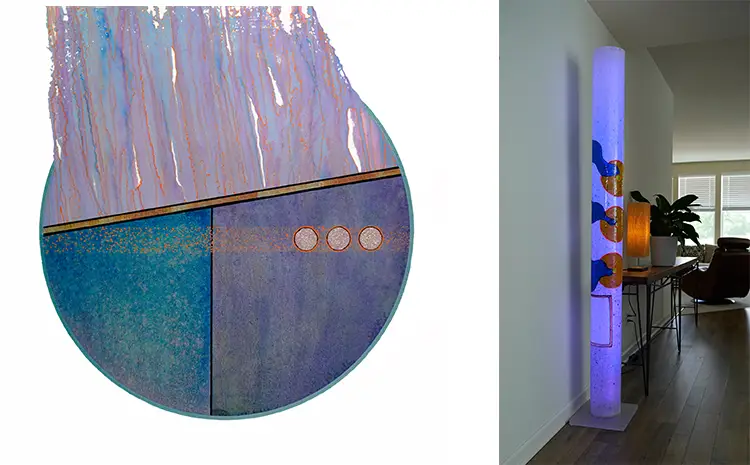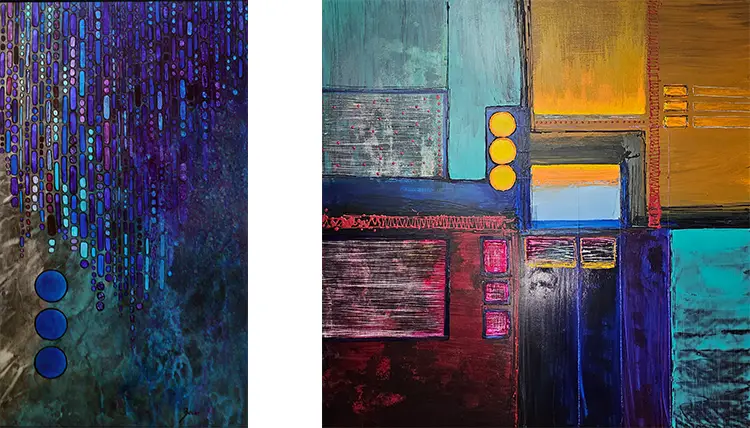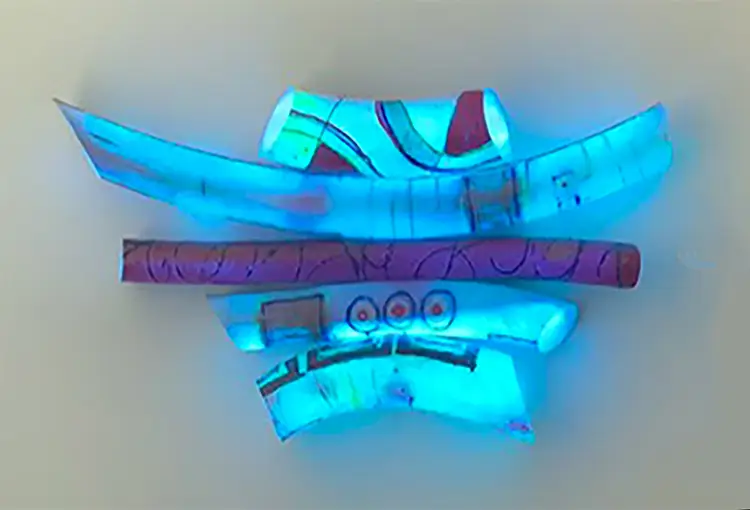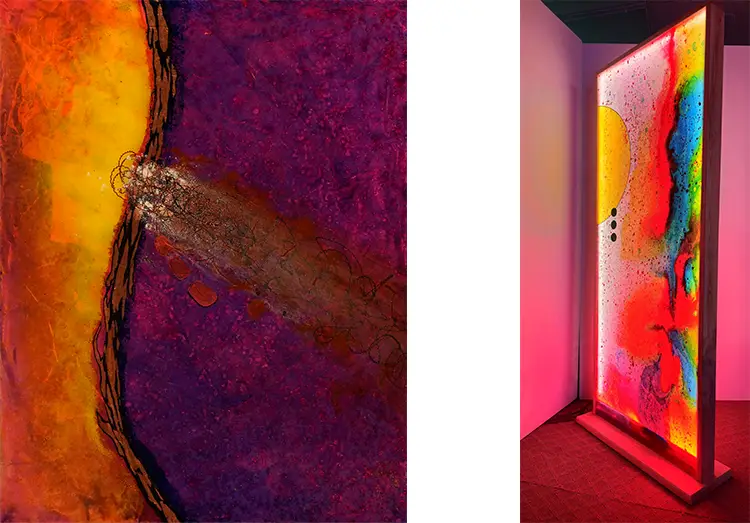“Abstract expressionism is one of the truest artforms—it’s strictly cerebral and comes from the depth of the artist’s soul.”
Shaping Vision: From Museum Dioramas to Multi-Medium Mastery
From a young age, Ray Zovar’s artistic path was illuminated not by a singular moment of revelation but by a constant, inner pull toward the act of creating. Growing up in Milwaukee just blocks from the city’s former museum—now the Milwaukee Public Library—he spent his formative years captivated by its intricate dioramas. These displays, where expertly painted backgrounds converged with sculptural foregrounds, revealed to Zovar the harmony between visual illusion and emotional storytelling. He didn’t just observe; he absorbed. That environment quietly molded the foundations of his evolving aesthetic, embedding in him an enduring reverence for balance, dimension, and sensory engagement that would define his lifelong practice.
Zovar’s trajectory wasn’t sparked by external inspiration; creativity simply flowed through him, as organic as breath. By early elementary school, he already identified as an artist. His first commission, a hammered bronze sculpture now permanently installed in a West Allis church, marked the start of a public-facing career while he was still very young. Rather than pursuing conventional paths, he followed instinct and intuition—often ignoring artistic formulas in favor of more dynamic, untethered expressions. Encouraged by a high school art teacher to defy expectations and avoid repetitive norms, Zovar carried that lesson forward. To this day, his work resists predictability, seeking not adherence to a style but the pursuit of something that feels entirely original with every creation.
Operating two distinct studios and a personal gallery in the burgeoning artistic hub of historic downtown Stoughton, Wisconsin, Zovar has developed a system that caters to the many facets of his creative life. His painting and luminous sculpture studio is a vibrant space equipped with an expansive array of tools, pigments, and experimental materials—anchored by what he describes as the most essential element: a conveniently placed sink. Nearby, his second studio supports his elaborate mosaic and glass work, allowing him to fulfill large-scale commissions, including wall fountains and tile installations. While some artists guard their solitude, Zovar thrives on interaction; visitors to his gallery are not intrusions, but rather vital sparks of energy that enrich his momentum.

Ray Zovar: Abstract Expressionism as Emotional Electricity
For Zovar, abstract expressionism isn’t simply a chosen style—it’s a raw, soul-driven necessity. He regards it as one of the purest forms of artistic communication, largely because it escapes rigid definitions and resists easy explanation. His works are born from cerebral intention but evolve with organic spontaneity, propelled by internal forces he likens to being “channeled” by something intangible. Each piece begins with an obsession for compositional balance. But once that initial structure is in place, the artwork takes over, unfolding with a kinetic energy that pushes both artist and viewer into unpredictable emotional terrain.
He does not pursue subject matter in the traditional sense. Instead, the theme of each piece reveals itself through its own process, led by a series of intuitive choices rather than premeditated designs. This makes Zovar’s art intensely personal, though not in a narrative way. Instead of telling stories, his works act as visual pulses, translating thought and feeling into layers of form and color. His avoidance of formulas is not just a matter of style—it’s a philosophical stance. Each project becomes a one-of-a-kind challenge, with its own demands, timing, and temperament.
Zovar’s avoidance of repetition also extends to his influences. While many artists narrow their focus, he embraces a diverse range of inspirations. Painters like Gustav Klimt and Ivan Albright fuel his appreciation for rich, intricate visual language. But just as powerful is his relationship with music—particularly jazz, jazz fusion, classical, and blues. These genres inform the structure and flow of his compositions, echoing their improvisational and emotional range. For Zovar, art and music are parallel forms of expression, both capable of leading the viewer—or listener—into entirely new dimensions.

The Interplay of Color, Light, and Material
One of Zovar’s most distinctive contributions to contemporary art is his luminous sculpture series, where internal LED lighting transforms surface design into a living, responsive visual experience. These pieces go beyond static viewing, offering an evolving encounter as the lighting shifts through controllable colors. The interaction between handcrafted exterior and internal illumination produces a dialogue that is never the same twice, inviting viewers to discover different moods and interpretations with every glance. It is in this series that his philosophy of movement and emotional activation is most powerfully realized.
His commitment to longevity also defines his choice of materials. Zovar has worked with an impressive spectrum of media throughout his career, from traditional oils and pastels to stained glass, fabric dyes, and hammered bronze. However, he now primarily employs waterborne materials, chosen for their resilience and archival quality. This insistence on durability is rooted in his belief that art should not only make an immediate impact, but also stand the test of time. By using the most lightfast pigments and robust mediums, he ensures that his work will endure physically even as its emotional resonance shifts with future viewers.
Mosaic and fused glass compositions form another important aspect of his practice. These works often find their way into architectural spaces, embedded as functional or decorative features. For these, he draws on a different set of tools and techniques, carefully balancing aesthetic vision with the demands of structure and placement. Whether designing a wall fountain or a tile inset, Zovar applies the same intensity and sense of balance that animates his paintings and sculptures. Each surface becomes a site of exploration—where geometry, texture, and reflection meet to form pieces that are as tactile as they are visual.

Ray Zovar: Always in Motion, Forever Inventing
Zovar’s artistic universe is anything but static. Even with an already expansive portfolio, he is continually exploring new shapes, concepts, and configurations—particularly within his luminous sculpture series. These works, though already established in his practice, continue to evolve as he considers alternate forms, color sequences, and arrangements. He treats each new variation not as a refinement but as a reimagining, guided by curiosity rather than conclusion. His process doesn’t follow a finish line; instead, it operates as a kind of perpetual experiment, where each completed piece suggests the possibility of an entirely different one just beyond reach.
Outside the luminous sculptures, he harbors a restless desire to cross mediums even further. His interest in jewelry and wearable art signals an urge to take his visual language into more intimate and mobile formats. Though not yet fully realized, these ideas reflect his resistance to being confined by category. Art, for Zovar, is not a fixed identity but a constantly shifting practice, one that can shape itself to fit new surfaces, purposes, and contexts. This exploratory instinct ensures that his work remains unpredictable, alive, and always pushing into new directions.
Through every phase of his career, Zovar has been motivated not by the approval of audiences or institutions but by an internal drive to create work that feels emotionally and visually complete. That sense of inner necessity has fueled a lifelong engagement with media and method, resulting in a body of work that is as diverse as it is cohesive. Whether working with pigments or LEDs, mosaics or glass, he creates environments that invite viewers to feel first and interpret later. In this way, Ray Zovar remains a compelling force in contemporary art—a visual illusionist who continues to redefine the boundaries between surface, light, and sensation.








